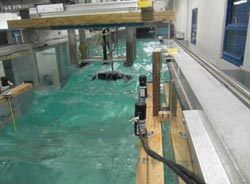Great Lakes Waterfowl Die-Offs: Finding the Source

FAU/K.von Ellenrieder<br><br>Experimental measurement of the drag on a partially submerged waterbird in waves <br>
A deadly menace stalks the loons, gulls, and other water birds of the Great Lakes region: Type E botulism, a neuromuscular disease caused when birds eat fish infected with toxin-producing bacteria. Cases of the disease are on the rise, killing approximately 10,000 more waterfowl in 2007 than when it was first reported in 1963.
To understand die-off origin and distribution, ocean engineers from the Florida Atlantic University (FAU) Institute for Ocean Systems Engineering in Dania Beach, Florida are using their expertise in experimental hydrodynamics. They have teamed with the U.S. Geological Survey to help develop a novel way of tracking waterfowl carcasses to determine the source of lethal outbreaks that infect fish eaten by waterbirds.
Monitoring the drift of waterbird carcasses associated with marine oil spills is another potential application. At the annual meeting of the American Physical Society's Division of Fluid Dynamics, held Nov. 24 26 in Pittsburgh, Pa., the team will present experimental measurements conducted to support the development of tracking software that will better determine the origin of waterbird die-offs.
The team performed towing tank experiments on submerging bird carcasses to determine the relevant drag coefficients. Together with wind and current data, these coefficients can be used in probabilistic source tracking simulations to calculate waterbird drift velocity and direction in order to reconstruct the likely routes that bird bodies may have traveled after a die-off.
Ultimately, this information will be compared to waterbird distribution and abundance revealed through aerial surveys to identify locations where waterbirds are likely exposed to botulinum toxin, explained Karl von Ellenrieder of FAU.
“Using the submerged frontal area of an ellipse, together with the frontal area of any submerged portions of the bird's head and neck gives good similarity across the range of speeds and submergence levels tested,” von Ellenrieder said. “This is the first effort we are aware of to obtain estimates of force parameters operating on drifting waterbirds for incorporation into a current and waved-based tracking model.”
The presentation, “Drag Coefficients of Drifting Waterbirds,” is at 9:44 a.m. on Sunday, November 24, 2013 in the David L. Lawrence Convention Center, Room 407. ABSTRACT: http://meeting.aps.org/Meeting/DFD13/Event/204308
MEETING INFORMATION
The 66th Annual Division of Fluid Dynamics Meeting will be held at David L. Lawrence Convention Center in Pittsburgh, Pennsylvania from November 24-26, 2013. More meeting information: http://www.apsdfd2013.pitt.edu
REGISTERING AS PRESS
Any credentialed journalist, full-time or freelance, may attend the conference free of charge. Please email: dfdmedia@aps.org and include “DFD Press” in the subject line. Workspace will be provided on-site during the meeting, and the week before news, videos and graphics will be made available on the Virtual Press Room: http://www.aps.org/units/dfd/pressroom/press.cfm
ABOUT THE APS DIVISION OF FLUID DYNAMICS
The Division of Fluid Dynamics (DFD) of the American Physical Society (APS) exists for the advancement and diffusion of knowledge of the physics of fluids with special emphasis on the dynamical theories of the liquid, plastic and gaseous states of matter under all conditions of temperature and pressure. DFD Website: http://www.aps.org/units/dfd/index.cfm
Media Contact
More Information:
http://www.aps.orgAll latest news from the category: Ecology, The Environment and Conservation
This complex theme deals primarily with interactions between organisms and the environmental factors that impact them, but to a greater extent between individual inanimate environmental factors.
innovations-report offers informative reports and articles on topics such as climate protection, landscape conservation, ecological systems, wildlife and nature parks and ecosystem efficiency and balance.
Newest articles

Combatting disruptive ‘noise’ in quantum communication
In a significant milestone for quantum communication technology, an experiment has demonstrated how networks can be leveraged to combat disruptive ‘noise’ in quantum communications. The international effort led by researchers…

Stretchable quantum dot display
Intrinsically stretchable quantum dot-based light-emitting diodes achieved record-breaking performance. A team of South Korean scientists led by Professor KIM Dae-Hyeong of the Center for Nanoparticle Research within the Institute for…

Internet can achieve quantum speed with light saved as sound
Researchers at the University of Copenhagen’s Niels Bohr Institute have developed a new way to create quantum memory: A small drum can store data sent with light in its sonic…





















